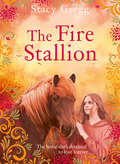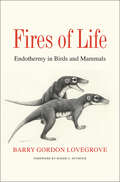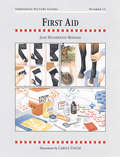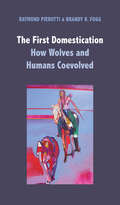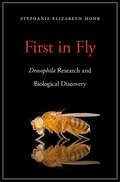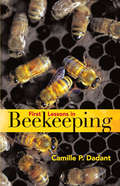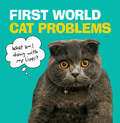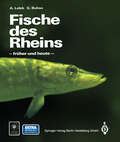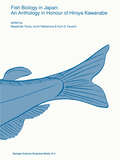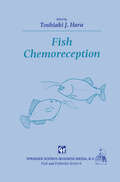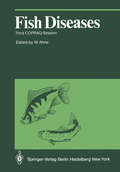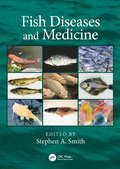- Table View
- List View
The Fire Stallion
by Stacy GreggAn enchanting and empowering standalone story from the author of The Princess and the Foal.
Fires of Life: Endothermy in Birds and Mammals
by Barry Gordon LovegroveA groundbreaking argument on how endothermy—arguably the most important innovation in vertebrate evolution—developed in birds and mammals This pioneering work investigates why endothermy, or “warm-bloodedness,” evolved in birds and mammals, despite its enormous energetic costs. Arguing that single-cause hypotheses to explain the origins of endothermy have stalled research since the 1970s, Barry Gordon Lovegrove advances a novel conceptual framework that considers multiple potential causes and integrates data from the southern as well as the northern hemisphere. Drawing on paleontological data; research on extant species in places like the Karoo, Namaqualand, Madagascar, and Borneo; and novel physiological models, Lovegrove builds a compelling new explanation for the evolution of endothermy. Vividly narrated and illustrated, this book stages a groundbreaking argument that should prove provocative and fascinating for specialists and lay readers alike.
FIRST AID (Threshold Picture Guide Ser. #No.12)
by JANE HOLDERNESS-RODDAMThis edition, substantially revised, reflects recent developments and practical advice on how to cope with common equine injuries and ailments. It explains when to call the veterinarian, and what to do before the vet arrives. New ideas are explored on wound care and laminitis.
First Dogs: American Presidents and Their Best Friends
by Brooke Janis Roy RowanPresidential History Unleashed—Fido to Fala, Millie to Bo "If you want a friend in Washington, get a dog," Harry Truman once said. Perhaps that's why, for much of our Republic's history, there have been two top dogs at 1600 Pennsylvania Avenue—one with two legs, one with four. First Dogs, by distinguished journalist Roy Rowan and researcher Brooke Janis, tells the whole doggone story, from the days before there was a White House to Barack Obama&’s newly adopted presidential pup, Bo. Here's a lighthearted romp through American history, packed with drawings and paintings from early America, plus photographs, starting with Abraham Lincoln's Fido. Not only did these four-footed goodwill ambassadors humanize their distinguished masters, they offered them a little unconditional love in a loveless town.First Dogs gives dog lovers and history lovers a new angle on presidential history and is more fun than you can shake a stick (or rubber bone) at.
The First Domestication: How Wolves and Humans Coevolved
by Raymond Pierotti Brandy R. FoggA riveting look at how dog and humans became best friends, and the first history of dog domestication to include insights from indigenous peoples In this fascinating book, Raymond Pierotti and Brandy Fogg change the narrative about how wolves became dogs and in turn, humanity’s best friend. Rather than describe how people mastered and tamed an aggressive, dangerous species, the authors describe coevolution and mutualism. Wolves, particularly ones shunned by their packs, most likely initiated the relationship with Paleolithic humans, forming bonds built on mutually recognized skills and emotional capacity. This interdisciplinary study draws on sources from evolutionary biology as well as tribal and indigenous histories to produce an intelligent, insightful, and often unexpected story of cooperative hunting, wolves protecting camps, and wolf-human companionship. This fascinating assessment is a must-read for anyone interested in human evolution, ecology, animal behavior, anthropology, and the history of canine domestication.
First in Fly: <i>Drosophila</i> Research and Biological Discovery
by Stephanie Elizabeth MohrA single species of fly, Drosophila melanogaster, has been the subject of scientific research for more than one hundred years. Why does this tiny insect merit such intense scrutiny? Drosophila’s importance as a research organism began with its short life cycle, ability to reproduce in large numbers, and easy-to-see mutant phenotypes. Over time, laboratory investigation revealed surprising similarities between flies and other animals at the level of genes, gene networks, cell interactions, physiology, immunity, and behavior. Like humans, flies learn and remember, fight microbial infection, and slow down as they age. Scientists use Drosophila to investigate complex biological activities in a simple but intact living system. Fly research provides answers to some of the most challenging questions in biology and biomedicine, including how cells transmit signals and form ordered structures, how we can interpret the wealth of human genome data now available, and how we can develop effective treatments for cancer, diabetes, and neurodegenerative diseases. Written by a leader in the Drosophila research community, First in Fly celebrates key insights uncovered by investigators using this model organism. Stephanie Elizabeth Mohr draws on these “first in fly” findings to introduce fundamental biological concepts gained over the last century and explore how research in the common fruit fly has expanded our understanding of human health and disease.
First in Fly: <i>Drosophila</i> Research and Biological Discovery
by Stephanie Elizabeth MohrA single species of fly, Drosophila melanogaster, has been the subject of scientific research for more than one hundred years. Why does this tiny insect merit such intense scrutiny? Drosophila’s importance as a research organism began with its short life cycle, ability to reproduce in large numbers, and easy-to-see mutant phenotypes. Over time, laboratory investigation revealed surprising similarities between flies and other animals at the level of genes, gene networks, cell interactions, physiology, immunity, and behavior. Like humans, flies learn and remember, fight microbial infection, and slow down as they age. Scientists use Drosophila to investigate complex biological activities in a simple but intact living system. Fly research provides answers to some of the most challenging questions in biology and biomedicine, including how cells transmit signals and form ordered structures, how we can interpret the wealth of human genome data now available, and how we can develop effective treatments for cancer, diabetes, and neurodegenerative diseases. Written by a leader in the Drosophila research community, First in Fly celebrates key insights uncovered by investigators using this model organism. Stephanie Elizabeth Mohr draws on these “first in fly” findings to introduce fundamental biological concepts gained over the last century and explore how research in the common fruit fly has expanded our understanding of human health and disease.
First Lessons in Beekeeping
by Camille Pierre DadantIn light of the dwindling honey bee population, this century-old guide is more relevant than ever. Written by the scion of a celebrated family of beekeepers that continues to operate today, the richly illustrated volume is the perfect companion for beginning beekeepers as well as those with a casual interest in bees. Reader-friendly information ranges from background on bee anatomy and the social structure of bee communities to different types of hives and how they function, honey production, wintertime beekeeping, and other practical matters. Author Camille Pierre Dadant was the son of Charles Dadant, one of the fathers of modern beekeeping techniques, inventor of the Dadant beehive, and founder of one of the first beekeeping equipment manufacturers. The business is still extant and run by the family, as is their publication, American Bee Journal. The old-fashioned charm of Dadant's narrative rests upon a solid foundation of timeless scientific knowledge, complemented by many informative drawings and photographs.
First Notes of Spring
by Jessica KulekjianNot Quite Narwhal meets And Then It's Spring in this funny, charming picture book debut about marching to the beat of your own drum to create a song that wakes Spring.Juniper can't wait to audition for the First Notes of Spring, the orchestra that melts away winter and wakes up spring with its melodies. With her strong sticks, thumpity toadstool, and rowdy rhythms, she plays with all her might. BOOMEY-BOOM-BOOM! But Mr. Moose says there's no room in the band for her loud percussion skills. Juniper is heartbroken, until she discovers other tappers, clappers, and noisemakers in the woods. As they parade through the forest playing music together, they learn that maybe their song can wake spring too.Watch the seasons change in this delightful picture book about being true to yourself, sure to leave readers with a spring in their step.
First Notes of Spring
by Jessica KulekjianNot Quite Narwhal meets And Then It's Spring in this funny, charming picture book debut about marching to the beat of your own drum to create a song that wakes Spring.Juniper can't wait to audition for the First Notes of Spring, the orchestra that melts away winter and wakes up spring with its melodies. With her strong sticks, thumpity toadstool, and rowdy rhythms, she plays with all her might. BOOMEY-BOOM-BOOM! But Mr. Moose says there's no room in the band for her loud percussion skills. Juniper is heartbroken, until she discovers other tappers, clappers, and noisemakers in the woods. As they parade through the forest playing music together, they learn that maybe their song can wake spring too.Watch the seasons change in this delightful picture book about being true to yourself, sure to leave readers with a spring in their step.
First Steps: How Walking Upright Made Us Human
by Jeremy DeSilvaHumans are the only mammals to walk on two, rather than four, legs. From an evolutionary perspective, this is an illogical development, as it slows us down. But here we are, suggesting there must have been something tremendous to gain from bipedalism.
First World Cat Problems: What am I doing with my lives?
by Pop PressBeing woken from an 8-hour nap by a car alarm. Fed tuna for dinner two days in a row.Going outside, only to realise instantly you want to be inside. Catching your owner looking at other cats on the internet. Losing your favourite toy under the sofa, and only having 64 others to choose from.This is just a handful of the many problems faced every day by a first-world cat. This book is finally giving him a voice.Because yes, the cat may have got the cream. But it probably wasn’t Waitrose extra thick double cream. And that’s the only kind he likes.
Fische des Rheins: — früher und heute —
by Anton Lelek Günter BuhseDer Rhein wird häufig als der schmutzigste Fluß Europas bezeichnet. Fest steht, daß er einen Wandel vom sauberen Lachsstrom zum beinahe "toten" Gewässer in den 70er Jahren hinter sich hat. Trotz aller Ereignisse war der Rhein niemals fischleer. Nach der Verbesserung der Wasserqualität Anfang der 80er Jahre hat sich der Fischbestand schnell erholt. Die Autoren wollen den Leser mit allen im Rhein lebenden Fischen vertraut machen. Dazu wurde der Rhein auf ganzer Länge, von Basel bis Emmerich, auf die vorhandenen Fischarten untersucht, und der heutige Bestand wurde mit den früher dort lebenden Fischgemeinschaften verglichen. Die wissenschaftliche Information ist so aufgearbeitet, daß sie jeder Laie verstehen kann. Die Fische werden beschrieben, in Zeichnungen und Farbbildern anschaulich gezeigt, ihre Lebensansprüche und ihre Verbreitung werden dargestellt. Gleichzeitig wird erklärt, warum bestimmte Fischarten relativ häufig vorkommen, andere aber völlig fehlen. Die Veränderungen und Belastungen des Flusses mit ihren Auswirkungen auf die Fischfauna sind chronologisch dargestellt; die Beschreibung des Ist-Zustands basiert auf umfangreichen Freilandarbeiten. Der Leser wird erkennen, daß der Fischbestand im Rhein den Zustand eines verbauten Flusses wiedergibt. Eine dauerhafte Erhaltung aller Fischarten wird nur mit Hilfe von ökotechnischen Maßnahmen, besonders im Bereich der Nebengewässer, der Flußauen und der einmündenden Zuflüsse möglich sein. Ein "Öko-Buch", nicht nur für Biologen oder Angler!
Fish and Diadromy in Europe (Developments in Hydrobiology #200)
by Sylvie Dufour Etienne Prevost Eric Rochard Patrick WilliotMost of the diadromous fish of the world have decreased in distribution and abundance since the beginning of the twentieth century. They are now threatened, and important conservation issues arise. The causes of these trends vary among species and basins but regional human impact (damming, pollution, fisheries) and global change (climate) are suspected to be responsible for these difficulties. This book contains selected papers from an international symposium organised by the Diadfish network held in Bordeaux (France) in 2005. Readers will find up-to-date information on the ecology, ecotoxicology and physiology of several diadromous species (Atlantic salmon, shads, lampreys, eels) and this whole group in Europe. Main impacts are also documented and analysed in case studies, and solutions or remediation actions are presented.
Fish and Fisheries in the Brazilian Amazon: People, Ecology and Conservation in Black and Clear Water Rivers
by Renato A. M. SilvanoThis book provides comparative data on fish ecology and small-scale fisheries between Tapajos (clear water) and Negro (black water) rivers, in the Brazilian Amazon. These rivers are less studied than white water rivers and few books on Amazon fishes have addressed more than one river basin. These data can serve as a baseline to check future changes or impacts in these rivers, which can be affected by development projects, such as highways, deforestation, mining and dams. Besides information on fish biology, the book also discusses fish uses, fisheries and its importance for riverine people, comparing these data for each fish species between sites located inside and outside conservation units. The book is an outcome of the research project ‘Linking sustainability of small-scale fisheries, fishers’ knowledge, conservation and co-management of biodiversity in large rivers of the Brazilian Amazon’, which was coordinated by the editor of this volume and funded by United States Agency for International Development (USAID) and National Academies of Science, Engineering and Medicine (NAS).
Fish Bioacoustics (Springer Handbook of Auditory Research #32)
by Jacqueline F. Webb Richard R. Fay Arthur N. PopperThis new definitive volume on fish auditory systems will interest investigators in both basic research of fish bioacoustics as well as investigators in applied aspects of fisheries and resource management. Topics cover structure, physiology, localization, and acoustic behavior as well as more applied topics such as using sound to detect and locate fish.
Fish biology in Japan: an anthology in honour of Hiroya Kawanabe (Developments in Environmental Biology of Fishes #18)
by Masahide Yuma Izumi Nakamura Kurt D. FauschFish biology in Japan: an anthology in honour of Hiroya Kawanabe (Developments in Environmental Biology of Fishes #18)
by Masahide Yuma Izumi Nakamura Kurt D. FauschFish Chemoreception (Fish & Fisheries Series #6)
by T. J. HaraThis book describes in general how the chemosensory systems of fish function at various levels. In many ways, fish are typical vertebrates differing only slightly from other vertebrates including humans. In other ways, their aquatic environment imposes strict requirements or offers unique opportunities which have resulted in some unusual functions having no counterpart in higher vertebrates. This new volume is necessitated by advances in many vital areas as the field of chemical senses continues to grow at a rapid pace. Most significant is the application of the contemporary electrophysiological technique of patch-clamping, recognition of a second messenger system in chemosensory transduction processes and the identification of hormonal pheromones in fish reproductive behaviour. The last major synthesis of our knowledge about fish chemoreception, Chemoreception in Fishes, was published ten years ago (Elsevier, Amsterdam, 1982). In that volume four aspects of fish chemoreception, Le. morphology of the peripheral chemoreceptors. primary sensory processes, roles in behaviour, and its interactions with environment, were discussed. This book is intended to be helpful to students, scientists and aquacul turists not only as a source book but also as a textbook on chemical senses.
Fish Cytogenetic Techniques: Ray-Fin Fishes and Chondrichthyans
by Catherine Ozouf-Costaz Eva Pisano Fausto Foresti Lurdes Foresti De Almeida ToledoRecent advances in fish cytogenetics have enhanced the interest in chromosome analysis in both fundamental (systematics and comparative genomics among fishes and other vertebrate groups) and applied (aquaculture, conservation and response to pollutants, whole genome sequencing of model fish species) research. Although the genomic material, the chro
Fish Disease: Diagnosis and Treatment
by Edward J. NogaFish Disease: Diagnosis and Treatment, Second Edition provides thorough, yet concise descriptions of viral, bacterial, fungal, parasitic and noninfectious diseases in an exhaustive number of fish species. Now in full color with over 500 images, the book is designed as a comprehensive guide to the identification and treatment of both common and rare problems encountered during the clinical work-up. Diseases are discussed following a systems-based approach to ensure a user-friendly and practical manual for identifying problems. Fish Disease: Diagnosis and Treatment, Second Edition is the must-have reference for any aquaculturists, aquatic biologists, or fish health specialists dealing with diagnosing or treating fish diseases.
Fish Disease: Diagnosis and Treatment
by Edward J. NogaFish Disease: Diagnosis and Treatment, Second Edition provides thorough, yet concise descriptions of viral, bacterial, fungal, parasitic and noninfectious diseases in an exhaustive number of fish species. Now in full color with over 500 images, the book is designed as a comprehensive guide to the identification and treatment of both common and rare problems encountered during the clinical work-up. Diseases are discussed following a systems-based approach to ensure a user-friendly and practical manual for identifying problems. Fish Disease: Diagnosis and Treatment, Second Edition is the must-have reference for any aquaculturists, aquatic biologists, or fish health specialists dealing with diagnosing or treating fish diseases.
Fish Diseases and Medicine
by Stephen A. SmithFish are critically important to the welfare of this planet and its occupants, the health of both wild and captive fish populations paramount to our survival. This book presents the gross pathology of the most commonly encountered diseases and syndromes of fish in an organ system-based approach. It provides an overview of the di
Fish Diseases and Medicine
by Stephen A. SmithFish are critically important to the welfare of this planet and its occupants, the health of both wild and captive fish populations paramount to our survival. This book presents the gross pathology of the most commonly encountered diseases and syndromes of fish in an organ system-based approach. It provides an overview of the di
